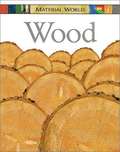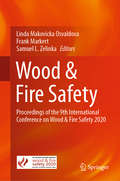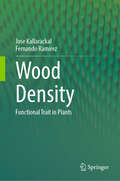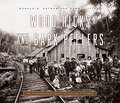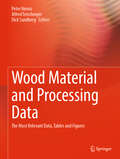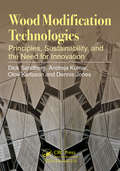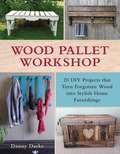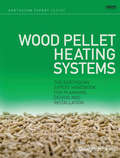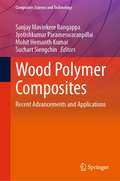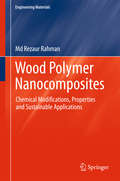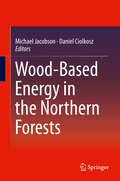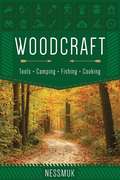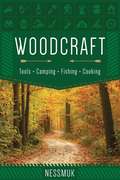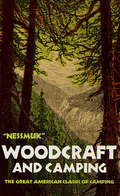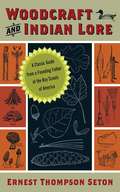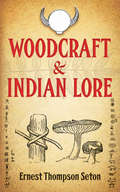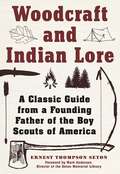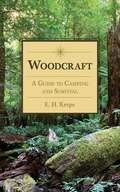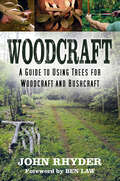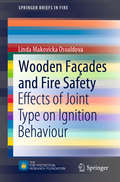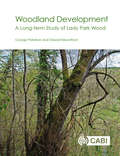- Table View
- List View
Wonders: Spectacular Moments in Nature Photography
by Rhonda RubinsteinNature is full of fleeting wonders. This breathtaking collection of nature photography reveals rare creatures, transports us to distant landscapes, and captures uncommon moments of drama and beauty in the natural world. From a heart-pounding shot of the Wildebeest Migration to a glimpse of the elusive Pampas cat, each image tells a story about the diversity and grandeur of life on earth. Bold, surprising, and jaw-droppingly beautiful, these photographs are all winners of the California Academy of Sciences' BigPicture Natural World Photography Competition. With more than 100 photographs and captions explaining the scientific phenomena and photographic techniques behind each picture, this book will captivate nature lovers, science enthusiasts, photographers, and adventurers.
Wood
by Claire LlewellynSoft, warm, heavy, slimy. . . which of these words describe metal or plastic, rubber or wood? This series covers them all -- with big colorful photographs, "Fascinating Facts, " and easy "Try This" experiments that introduce simple science concepts in a fun and engaging way, and show how each material is produced, transformed for everyday use, and impacts the environment. That paper plate in the lunchroom will never seem the same again once readers really get to know their Material World!
Wood
by Rebel WilliamsA daughter explains the processes her and her father went through to build their dog house.
Wood & Fire Safety: Proceedings of the 9th International Conference on Wood & Fire Safety 2020
by Linda Makovicka Osvaldova Frank Markert Samuel L. ZelinkaThis proceedings volume presents new scientific works of the research workers and experts from the field of Wood Science & Fire.It looks into the properties of various tree species across the continents affecting the fire-technical properties of wood and wood-based materials, its modifications, fire-retardant methods and other technological processes that have an impact on wood ignition and burning. The results of these findings have a direct impact on Building Construction and Design describing the fire safety of wooden buildings, mainly large and multi-story ones. The results of these experiments and findings may be applied, or are directly implemented into Fire Science, Hazard Control, Building Safety which makes the application of wood and wood materials in buildings possible, while maintaining strict fire regulations.One part of the contributions focuses on the symbiosis of the material and the fire-fighting technologies. Wood burning has its own specific features, therefore, the fire protection technologies need to be updated regularly. It also includes the issue of the intervention of fire-fighting and rescue teams in the fires of wooden buildings. Presentations deal with the issue of forest fires influenced by the climate changes, relief, fuel models based on the type and the age of the forest stand.
Wood Density: Functional Trait in Plants
by Fernando Ramírez Jose KallarackalRecent research has shed light on the crucial role of wood density, a fundamental physical property, as a functional trait. This means wood density isn't just about how much a piece of wood weighs, but how it influences a plant's entire strategy for survival and growth. While variations exist between individual species, a surprising trend has emerged: the majority of this variation can be traced back to a plant's genus or even family. This strong phylogenetic signal indicates that wood density is a deeply ingrained characteristic, shaped by a plant's evolutionary history. This newfound understanding allows us to leverage wood density as a taxon-based functional trait. By considering the typical wood density of a plant group (like a genus or family), we can improve models and predictions related to various ecological and functional aspects in forests and plantations. Over the past couple of decades, scientists have been actively exploring the connections between wood density and a wide range of plant functions. Denser wood is often linked to slower growth rates, delayed reproduction, and increased mechanical strength. It also influences a plant's ability to transport water, resist death (mortality rate), and manage internal water balance (water potential). Additionally, wood density is closely tied to physiological aspects such as gas exchange and xylem hydraulic conductance, which are crucial for nutrient and water movement. Wood density is also an important parameter to determine the carbon sequestration capacity of a tree or vegetation, thus important in climate change research. This proposed book will delve into these fascinating connections, highlighting how wood density acts as a key player in shaping the lives of plants and the overall health of forest ecosystems.
Wood Hicks and Bark Peelers: A Visual History of Pennsylvania’s Railroad Lumbering Communities; The Photographic Legacy of William T. Clarke (Keystone Books)
by Ronald E. Ostman Harry LittellIn Wood Hicks and Bark Peelers, Ronald E. Ostman and Harry Littell draw on the stunning documentary photography of William T. Clarke to tell the story of Pennsylvania’s lumber heyday, a time when loggers serving the needs of a rapidly growing and globalizing country forever altered the dense forests of the state’s northern tier.Discovered in a shed in upstate New York and a barn in Pennsylvania after decades of obscurity, Clarke’s photographs offer an unprecedented view of the logging, lumbering, and wood industries during the late nineteenth and early twentieth centuries. They show the great forests in the process of coming down and the trains that hauled away the felled trees and trimmed logs. And they show the workers—cruisers, jobbers, skidders, teamsters, carpenters, swampers, wood hicks, and bark peelers—their camps and workplaces, their families, their communities. The work was demanding and dangerous; the work sites and housing were unsanitary and unsavory. The changes the newly industrialized logging business wrought were immensely important to the nation’s growth at the same time that they were fantastically—and tragically—transformative of the landscape. An extraordinary look at a little-known photographer’s work and the people and industry he documented, this book reveals, in sharp detail, the history of the third phase of lumber in America.
Wood Hicks and Bark Peelers: A Visual History of Pennsylvania’s Railroad Lumbering Communities; The Photographic Legacy of William T. Clarke (Keystone Books)
by Ronald E. Ostman Harry LittellIn Wood Hicks and Bark Peelers, Ronald E. Ostman and Harry Littell draw on the stunning documentary photography of William T. Clarke to tell the story of Pennsylvania’s lumber heyday, a time when loggers serving the needs of a rapidly growing and globalizing country forever altered the dense forests of the state’s northern tier.Discovered in a shed in upstate New York and a barn in Pennsylvania after decades of obscurity, Clarke’s photographs offer an unprecedented view of the logging, lumbering, and wood industries during the late nineteenth and early twentieth centuries. They show the great forests in the process of coming down and the trains that hauled away the felled trees and trimmed logs. And they show the workers—cruisers, jobbers, skidders, teamsters, carpenters, swampers, wood hicks, and bark peelers—their camps and workplaces, their families, their communities. The work was demanding and dangerous; the work sites and housing were unsanitary and unsavory. The changes the newly industrialized logging business wrought were immensely important to the nation’s growth at the same time that they were fantastically—and tragically—transformative of the landscape. An extraordinary look at a little-known photographer’s work and the people and industry he documented, this book reveals, in sharp detail, the history of the third phase of lumber in America.
Wood Material and Processing Data: The Most Relevant Data, Tables, and Figures
by Dick Sandberg Peter Niemz Alfred TeischingerThe book is intended for professionals in the field of materials science, construction technology and operational design of new facilities. Characteristic values for the calculation, project planning and process optimization are often important for the engineer working in the project planning of plants. Therefore, characteristic values for solid wood from different continents and for wood-based materials and modified wood are compiled in tabular form. Important adhesives and coating materials complete the collection of characteristic values. Standards from Europe, the USA, Russia and China are also listed. Information on material consumption, energy consumption and material utilization are also included (sawn wood, wood based material, pulp and paper). Other important information and a list of specialist books complete the data collection. The data supplement the knowledge in existing specialist books and compendiums in the field of wood science and wood technology, with a large numberof specific details that are only briefly compiled in specialist articles or specialist books.
Wood Modification Technologies: Principles, Sustainability, and the Need for Innovation
by Dennis Jones Andreja Kutnar Dick Sandberg Olov KarlssonThe market for durable products using modified wood has increased substantially during the last few years. This is partly because of the restriction on the use of toxic preservatives due to environmental concerns, and to lower maintenance cost and time. Furthermore, as sustainability becomes a greater concern, the environmental impact of construction and interior materials is factored in planning by considering the whole life cycle and embodied energy of the materials used. Wood is modified to improve its intrinsic properties, enhance the range of applications of timber, and to acquire the form and functionality desired by engineers without calling the environmental friendliness into question. Wood modification processes are at various stages of development, and the challenges faced in scaling up to industrial applications differ. The aim of this book is to put together the key elements of the changes of wood constituents and the related changes in wood properties of modified wood. Further, a selection of the principal technologies implemented in wood modification are presented. This work is intended for researchers, professionals of timber construction, as well as students studying the science of materials, civil engineering and architecture. This work is not exhaustive, but intends to deliver an outline of the scientific disciplines necessary to apprehend the technologies of wood modification and its behavior during treatment, as well as during its use.
Wood Pallet Workshop: 20 DIY Projects that Turn Forgotten Wood into Stylish Home Furnishings
by Danny DarkeWooden shipping pallets have found an unlikely second life: beautiful, handcrafted home décor without the designer price. The DIY market has long been drawn to refurbishing furniture and interior design on a budget, but easily accessible wood pallets have opened up all-new and inspiring ways to personalize a home in an eco-friendly, low-cost way.Until recently, upcycling required crafters to hunt for goods and furniture at yard sales and online, and many refurbishing books could only offer tips for specific pieces. With wooden pallets, the scope of the project is boundless, and warehouses and stores are happy to give them away for free. What was once a scavenger hunt and test of skill for experienced DIYers can now be an easy weekend project for even the newest of crafters.Wood Pallet Workshop will be a book of inspiration as well as a hardworking instructional guide for an array of projects. With 20 easy-to-follow designs ranging from coffee tables and wine racks to decorative wall art and step-by-step photos, this book will be a go-to instructional guide for DIYers looking for simple and creative ways to decorate their homes.
Wood Pellet Heating Systems: The Earthscan Expert Handbook on Planning, Design and Installation (Earthscan Expert Ser.)
by Dilwyn JenkinsWood Pellet Heating Systems is a comprehensive handbook covering all aspects of wood pellet heating technology. The use of wood pellets as an alternative heating fuel is already well established in several countries and is becoming widespread as fossil fuel prices continue to rise and awareness of climate change grows. Wood pellets are a carbon-neutral technology, convenient to use, and can easily be integrated into existing central heating systems or used in independent space heaters. This fully-illustrated and easy-to-follow guide shows how wood-pellet heating works, the different types of systems – from small living room stove systems to larger central heating systems for institutions – how they are installed, and even how wood pellets are manufactured. Featuring examples from around the world, it has been written for heating engineers and plumbers who are interested in installing systems, home owners and building managers who are considering purchasing a system, advanced DIYers, building engineers and architects, but will be of interest to anyone who requires a clear guide to wood pellet technology.
Wood Polymer Composites: Recent Advancements and Applications (Composites Science and Technology)
by Jyotishkumar Parameswaranpillai Suchart Siengchin Sanjay Mavinkere Rangappa Mohit Hemanth KumarThis book comprehensively covers the different topics of wood polymer composite materials mainly synthesis methods for the composite materials, various characterization techniques to study the superior properties and insights on potential advanced applications. It also discusses the chemistry, fabrication process, properties, applications, recycling and life cycle assessment of wood polymer composites. This is a useful reference source for both engineers and researchers working in composite materials science as well as the students attending materials science, physics, chemistry and engineering courses.
Wood Polymer Nanocomposites
by Md Rezaur RahmanThis book shows how chemical modifications influence some properties of wood nanocomposites. It describes suitable and effective chemical modifications that strengthen the physico-mechanical, thermal and morphological properties of wood. The authors provide intuitive explanation of the various types of chemical modifications applied to polymer cell walls in wood. They emphasize the reaction changes in wood cell walls due to the chemical modifications. Increased mechanical strength, improved thermal stability as well as the efficient retardancy against fungi attack are described. This book concludes summarizing the potential applications of wood-based nanocomposites taking into account sustainability and economic aspects.
Wood-Based Energy in the Northern Forests
by Michael Jacobson Daniel CiolkoszThis unique book provides the first comprehensive overview of wood based bioenergy in the northern hardwood forests of the Eastern United States. This includes a holistic look at the topic of wood based bioenergy, as well as focused analyses of key topics. This book is relevant to engineers, project developers, foresters, economists, sociologists, environmental scientists and natural resource managers. Most chapters also provide practical hands-on advice for the practitioner, and provide a valuable resource for anyone who is considering developing a woody bioenergy project.
Woodchucks (Nature's Children)
by Laima DingwallWhich North American animal has a holiday named after him? Do woodchucks really sleep through the winter? What do groundhogs eat? Read all about the physical characteristics, habits, and natural environment of woodchucks.
Woodcraft
by George W. SearsLegendary canoeing guide, conservationist in the 1800s, and one of the first proponents of the popular "ultralight" camping style, George Washington Sears (who used the pen name "Nessmuk") was a true American mountain man. Using a 9 foot long, 10 ½ pound canoe, he successfully completed a 266 mile journey through the central Adirondacks. His classic treatise on American camping, Woodcraft, is definitive proof that he was the most capable and intelligent woodsman of his time.First published in 1900, and continuously in print ever since then, this is the ultimate book for hikers, campers, fishers, canoers, and anyone else who feels the call of the wild. With information on what to bring, how to build fires, how to fish with and without flies, and how to cook, this book remains relevant in our modern society. For anyone with even a passing interest in getting closer to nature, this is required reading. The forerunner of the ultralight camping movement and the precursor to all other books on camping and traveling through the wilderness, Woodcraft belongs on the bookshelf of every aspiring mountain person.
Woodcraft
by NessmukLegendary canoeing guide, conservationist in the 1800s, and one of the first proponents of the hyper popular "ultra-light” camping style, George Washington "Nessmuk” Sears was a true American mountain man. Using a 9-foot-long, 10 and a half pound canoe he successfully completed a 266-mile journey through the central Adirondacks. His classic treatise on American camping, Woodcraft , is definitive proof that he was the most capable and intelligent woodsman of his time.First published in 1884, and continuously in print ever since then, this is the ultimate book for hikers, campers, fishers, canoers, and anyone else who feels the call of the wild. With information on what to bring, how to build fires, how to fish with and without flies, and how to cook, this book is still totally relevant in our modern society. For anyone with even a passing interest in getting closer to nature this is required reading. The forerunner of the ultra-light camping movement and the precursor to all other books on camping and traveling through the wilderness, Woodcraft belongs on the bookshelf of every aspiring mountain person.Skyhorse Publishing is proud to publish a broad range of books for fishermen. Our books for anglers include titles that focus on fly fishing, bait fishing, fly-casting, spin casting, deep sea fishing, and surf fishing. Our books offer both practical advice on tackle, techniques, knots, and more, as well as lyrical prose on fishing for bass, trout, salmon, crappie, baitfish, catfish, and more. While not every title we publish becomes a New York Times bestseller or a national bestseller, we are committed to publishing books on subjects that are sometimes overlooked by other publishers and to authors whose work might not otherwise find a home.
Woodcraft and Camping
by George NessmukOne of America's most famous woodsmen and nature experts provides classic instructions for roughing it. His advice covers camping, hiking, building a fire, cooking out, shelters, tools and equipment, hunting and fishing, canoeing, and more. "Useful, specific information and suggestions on all aspects of woodcraft." — Moor and Mountain.
Woodcraft and Indian Lore
by Ernest Thompson Seton"I should like to lead this whole nation into the way of living outdoors," wrote Ernest Seton over seventy-five years ago. If the nation was in need of a dose of nature then, we can certainly benefit even more from Seton's sage advice now. Learn how to build a campfire, a dam, or a birch bark basket; to recognize animal tracks, constellations, and all manner of forestry; to stop a nose-bleed, ease poison ivy, or soothe a sore throat with natural remedies; to make delicious biscuits on the trail and spot edible mushrooms; and more. This book is essential for Boy Scouts and their leaders, and great fun for anyone desiring a fuller experience of outdoors life.
Woodcraft and Indian Lore: A Classic Guide From A Founding Father Of The Boy Scouts Of America (Native American)
by Ernest SetonNaturalist and artist Ernest Thompson Seton was a founding pioneer of the Boy Scouts of America who introduced many elements of Native American lore to scouting rituals. In this comprehensive collection of his most interesting stories, crafts, games, and other activities related to outdoor life, Seton offers a respectful and informative tribute to Native American culture. More than 500 of his drawings illustrate this practical guide for campers of all ages. In addition to briefly outlining the principles of scouting, Seton discusses Indian customs and laws as well as songs, dances, and ceremonies. He suggests both indoor and outdoor activities and provides a wealth of information on Indian sign language and games, campfire tales, forestry, and many other captivating facts and fancies.
Woodcraft and Indian Lore: A Classic Guide from a Founding Father of the Boy Scouts of America (Native American Ser.)
by Ernest Thompson SetonAt the turn of the twentieth century, an age of booming technology and a rapid reduction of the outdoors, wildlife enthusiast Ernest Thompson Seton called for a renewed interest in outdoor living. If the nation was in need of a dose of nature then, we could certainly benefit from Seton's expert guidance today. With this book, you'll learn to: Build a campfire, dam, or birch basket Recognize animal tracks, constellations, and all manner of forestry Spot the differences between poisonous plants and edible berries Remedy everything from common cuts and wounds to life-threatening snakebites And much more!Combining scientific knowledge with Native American wisdom and practices, this guide is essential for Boy Scouts, their pack leaders, and any guides leading outdoor treks. It's also a great read for any outdoors lover who is looking for a fuller experience of nature.Skyhorse Publishing is proud to publish a broad range of books for hunters and firearms enthusiasts. We publish books about shotguns, rifles, handguns, target shooting, gun collecting, self-defense, archery, ammunition, knives, gunsmithing, gun repair, and wilderness survival. We publish books on deer hunting, big game hunting, small game hunting, wing shooting, turkey hunting, deer stands, duck blinds, bowhunting, wing shooting, hunting dogs, and more. While not every title we publish becomes a New York Times bestseller or a national bestseller, we are committed to publishing books on subjects that are sometimes overlooked by other publishers and to authors whose work might not otherwise find a home.
Woodcraft: A Guide to Camping and Survival
by E H. KrepsIf you have ever wished you could escape to your own Walden Pond, consider creating a unique wilderness haven with the instructions found in this book! While woodcraft usually brings furniture to mind, this book is a guide to the craft of extended camping and travel in the woods. First published in 1919, this wilderness book, complete with illustrations, teaches you how to construct a simple log cabin, live off the land, build different types of fires, make snowshoes, and use outdoor tools. With all the modern conveniences of camping today, these forgotten skills are invaluable for those longing to return to a simpler, more self-sufficient time.Written by an expert woodsman, the easy to follow sections make this suitable for both young and old adventurers. Exploring the unknown is often daunting, but with the lessons found in this book, even the most novice of backpackers will know how to use a compass so they won't get lost, the types of camp foods they should bring to sustain their energy, and how to make shelter to stay safe from the elements. With the basics taken care of, go forth into the woods and trek the pathless forest--just don't forget to bring this timeless guide with you!
Woodcraft: A Guide to Using Trees for Woodcraft and Bushcraft
by John Rhyder‘A few tools and a wide range of skills can achieve many things …’If you've ever wanted to make your own bow and arrows, learn to create fire using friction, or mix up glue and dyes from the natural resources that surround us, then this is the book for you. John Rhyder has taught traditional woodcraft skills for several decades and can now teach you in this no-nonsense, amusing and easy-to-follow guide.Woodcraft will take you on a practical learning journey – from the safe use of tools and sustainable harvesting of wood to the subsequent uses for roots, bark and timber. This step-by-step account is suitable for the student of woodcraft, the naturalist and the practitioner of bushcraft skills.
Wooden Façades and Fire Safety: Effects of Joint Type on Ignition Behaviour (SpringerBriefs in Fire)
by Linda Makovicka OsvaldovaThis book presents the results of an experiment assessing the impact of spruce wood joints on the creation and development of fire when these joints are applied within a façade. The book includes an extensive analysis of wooden cladding, which is a flammable material in which the elements are connected lengthwise using various types of joint. The parameters of the experiment, as well as the setting, material criteria and evaluation criteria are described in detail. The results confirm that the joint type used has an impact on the selected evaluation criteria and thus also on the potential spread of fire.
Woodland Development
by George F. Peterken Edward P. MountfordIn 1944 Lady Park Wood (45 hectares of woodland in Gloucestershire and Monmouthshire, UK) was set aside indefinitely by the Forestry Commission so that ecologists could study how woodland develops naturally. Since then, in a unique long-term study, individual trees and shrubs have been recorded at intervals, accumulating a detailed record of more than 20,000 individual beech, sessile oak, ash, wych elm, small-leaved lime, large-leaved lime, birch, hazel, yew and other species. In the seven decades since the study started, the wood has changed; trees grew, died and regenerated, and drought, disease and other events shaped its destiny. Each tree and shrub species reacted in its own way to changes in the wood as a whole and to changes in the fortunes of its neighbours. Meanwhile, the wild fauna, flora and fungi also responded, leaving the wood richer in some groups but poorer in others. In this landmark book, beautifully illustrated throughout, George Peterken and Edward Mountford, summarise the ongoing results of the Lady Park Wood study, highlighting its unique place in nature conservation and its significance to ecology in general. It also builds on experience at Lady Park Wood and elsewhere to discuss in particular: the role and maintenance of long-term ecological studies; the concept and form of natural woodland; the role of minimum-intervention policies in woodland nature conservation; near-to-nature forestry; and the desirability and practicalities of re-wilding woodlands.

